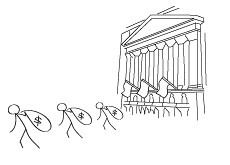Money Out—Also, Money In
By
Mattea Kramer
Posted:
|
Budget Process,
Transparency & Data
There’s so much talk these days about federal deficits and cutting spending. So we at NPP thought it would be good to talk about tax revenues—the other half of the budget picture—and not just about spending (For some background on how the budget works, check out the People’s Guide to the Federal Budget)
Some folks say the government is “bankrupt,” but a look at Costoftaxcuts.com suggests that temporary tax cuts, enacted by President Bush and extended through 2012 by President Obama, have a lot to do with current deficits.
For example,
• Bush tax cuts for the richest 5% added on average 14% to federal deficits from 2001 to 2010, or roughly $100 billion in extra deficit spending each year. Over ten years, that’s around $1 trillion of extra debt (a.k.a. $1,000,000,000,000).
• While the official tax rate for U.S. corporations is one of the highest in the world, loopholes make actual corporate tax rates much lower than peer nations’. The Congressional Budget Office found that corporate taxes as a percentage of GDP are lower in the United States than in almost every other developed nation. Plus, corporate taxes as a percentage of U.S. federal revenues have been falling for decades, according to the White House Office of Management and Budget. (For more on this: “What About Corporate Taxes?”)
